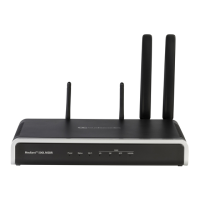User's Manual 334 Document #: LTRT-10466
Mediant 500L MSBR
Parameter Description
Web: RTP IP DiffServ
CLI: rtp-ip-diffserv
[IpProfile_IPDiffServ]
Defines the DiffServ value for Premium Media class of
service (CoS) content.
The valid range is 0 to 63. The default is 46.
Note: The corresponding global parameter is
PremiumServiceClassMediaDiffServ.
Web: Signaling DiffServ
CLI: signaling-diffserv
[IpProfile_SigIPDiffServ]
Defines the DiffServ value for Premium Control CoS content
(Call Control applications).
The valid range is 0 to 63. The default is 40.
Note: The corresponding global parameter is
PremiumServiceClassControlDiffServ.
Web: RTP Redundancy Depth
CLI: rtp-redundancy-depth
[IpProfile_RTPRedundancyDepth]
Enables the device to generate RFC 2198 redundant
packets. This can be used for packet loss where the missing
information (audio) can be reconstructed at the receiver's
end from the redundant data that arrives in subsequent
packets. This is required, for example, in wireless networks
where a high percentage (up to 50%) of packet loss can be
experienced.
[0] 0 = (Default) Disable.
[1] 1 = Enable - previous voice payload packet is added
to current packet.
Notes:
When enabled, you can configure the payload type, using
the RFC2198PayloadType parameter.
The RTP redundancy dynamic payload type can be
included in the SDP, by using the
EnableRTPRedundancyNegotiation parameter.
The corresponding global parameter is
RTPRedundancyDepth.
Web: Disconnect on Broken
Connection
CLI: disconnect-on-broken-connection
[IpProfile_DisconnectOnBrokenCon
nection]
Defines the device's handling of calls when RTP packets
(media) are not received within a user-defined timeout
(configured by the BrokenConnectionEventTimeout
parameter).
[0] Ignore = The call is maintained despite no media and
is released when signaling ends the call (i.e., SIP BYE).
[1] Disconnect = (Default) The device ends the call.
[2] Reroute = (SBC application only) The device ends the
call and searches the IP-to-IP Routing table for a
matching rule and if found, generates a new INVITE to
the corresponding destination (i.e., alternative routing).
You can configure a routing rule whose matching
characteristics is explicitly for calls with broken RTP
connections. This is done using the Call Trigger
parameter, as described in Configuring SBC IP-to-IP
Routing Rules on page 564.
Note:
The device can only detect a broken RTP connection if
silence compression is disabled for the RTP session.
If during a call the source IP address (from where the
RTP packets are received by the device) is changed
without notifying the device, the device rejects these RTP
packets. To overcome this, configure the
DisconnectOnBrokenConnection parameter to 0. By this

